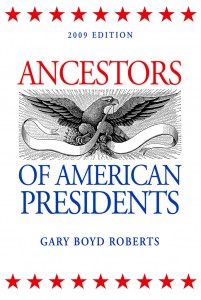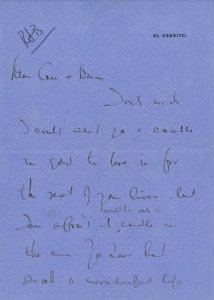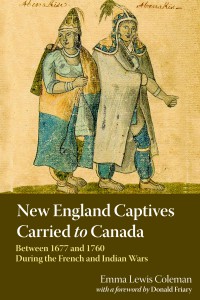 Yikes! Just as I was starting to write this post following-up on the discussion engendered by my penultimate post, I learned that I made an egregious (and embarrassing) mistake regarding Mayflower passengers in the sketch on Samuel Maverick – I made the mother of Rebecca Allerton, who married Sam’s brother Moses Maverick, her step-mother, Fear (Allerton) Brewster. This is the second time I’ve done something like this – the first was back in the beginning of the project when I made Samuel Fuller’s uncle his father. After forty years of working with Mayflower families, I used to know all of this like the back of my hand, but the backs of my hands these days are getting wrinkly and veiny, and clearly the back of my mind has had to shed some information to make room for all the new material coming in from the Early New England Families Study Project. I just have to remember to remember that. Continue reading Catch-22s
Yikes! Just as I was starting to write this post following-up on the discussion engendered by my penultimate post, I learned that I made an egregious (and embarrassing) mistake regarding Mayflower passengers in the sketch on Samuel Maverick – I made the mother of Rebecca Allerton, who married Sam’s brother Moses Maverick, her step-mother, Fear (Allerton) Brewster. This is the second time I’ve done something like this – the first was back in the beginning of the project when I made Samuel Fuller’s uncle his father. After forty years of working with Mayflower families, I used to know all of this like the back of my hand, but the backs of my hands these days are getting wrinkly and veiny, and clearly the back of my mind has had to shed some information to make room for all the new material coming in from the Early New England Families Study Project. I just have to remember to remember that. Continue reading Catch-22s
Tag Archives: Great Migration Study Project
The skipped generation
 Three more sketches (16 pages) in the Early New England Families Study Project have just been posted – John Carter of Woburn; Samuel Maverick of Noddles Island, Boston, Maine, New York, etc.; and his wife Amyas (Cole) (Thomson) Maverick.
Three more sketches (16 pages) in the Early New England Families Study Project have just been posted – John Carter of Woburn; Samuel Maverick of Noddles Island, Boston, Maine, New York, etc.; and his wife Amyas (Cole) (Thomson) Maverick.
John Carter is the first example in the Early New England Families Study Project of a second-generation New Englander who arrived with his parents during the “second,” unpublished, half of the Great Migration. This results in the anomaly that John Carter’s sketch is published before his father’s, which might confuse researchers assuming that the two projects are seamlessly synced. Continue reading The skipped generation
Three years in
 We are just about to start the fourth year of the Early New England Families Study Project. There are presently 72 sketches online, and now the first of the hard copy publications covering 50 families is available as well. New sketches scheduled to be uploaded in January include Samuel Maverick and his wife Amias (Cole) (Thompson) Maverick.
We are just about to start the fourth year of the Early New England Families Study Project. There are presently 72 sketches online, and now the first of the hard copy publications covering 50 families is available as well. New sketches scheduled to be uploaded in January include Samuel Maverick and his wife Amias (Cole) (Thompson) Maverick.
These sketches have definitely developed into far more detailed and complex endeavors than we originally conceived. It isn’t that we thought it was going to be easy, but we did have some hopes that “summarizing” a couple of centuries of collected works on these families would be simpler that it is turning out to be. So why is that? Continue reading Three years in
2015: the year in review concluded
 On the first day of 2016, Vita Brevis can boast 780,157 page views over the life of the blog. With dozens of voices writing for the blog, I hope that readers will check back often to see what’s new at Vita Brevis. Following yesterday’s blog post, here follows a snapshot of the second six months of 2015 at the blog.
On the first day of 2016, Vita Brevis can boast 780,157 page views over the life of the blog. With dozens of voices writing for the blog, I hope that readers will check back often to see what’s new at Vita Brevis. Following yesterday’s blog post, here follows a snapshot of the second six months of 2015 at the blog.
Robert Charles Anderson’s post on the new Great Migration Directory was published on 1 July:
The Great Migration Directory attempts to include all those who immigrated to New England during the Great Migration, and only those immigrants. After much examination of the historical record, and particularly of the activities of the passenger vessels each spring, I determined that the Great Migration ended during 1640, and so this volume is designed to include every head of household or unattached individual who arrived between 1620 and 1640. Continue reading 2015: the year in review concluded
Saturday’s Fireside Chat
 On Saturday I had the honor and fun of joining with Bob Anderson and Chris Child in a Fireside Chat in the Treat Rotunda at NEHGS. We were each touting publications for sale – Bob’s Great Migration Directory (so popular it has sold out and there were none to physically sell that day!); Chris Child’s first issue of Mayflower Descendant under the new banner of NEHGS, which will be available in January; and Volume 1 of my Early New England Families series. The “Chats,” which took place in three sessions throughout the day, included interesting questions from our moderators, Jim Power and Penny Stratton, and from the audience about our projects, how we all got started in genealogy, and how we work. There were at least 150 people who came for the special day of discount prices in the bookstore, access to the library, and to hear stories from two old genealogists (Bob and I), many of which predated Chris’ birth. I think everyone enjoyed the event. Continue reading Saturday’s Fireside Chat
On Saturday I had the honor and fun of joining with Bob Anderson and Chris Child in a Fireside Chat in the Treat Rotunda at NEHGS. We were each touting publications for sale – Bob’s Great Migration Directory (so popular it has sold out and there were none to physically sell that day!); Chris Child’s first issue of Mayflower Descendant under the new banner of NEHGS, which will be available in January; and Volume 1 of my Early New England Families series. The “Chats,” which took place in three sessions throughout the day, included interesting questions from our moderators, Jim Power and Penny Stratton, and from the audience about our projects, how we all got started in genealogy, and how we work. There were at least 150 people who came for the special day of discount prices in the bookstore, access to the library, and to hear stories from two old genealogists (Bob and I), many of which predated Chris’ birth. I think everyone enjoyed the event. Continue reading Saturday’s Fireside Chat
A grave concern
 Over the past thirty years I have examined thousands of old slate gravestones in the cemeteries of New England. This fascination led me to write A Guide to Massachusetts Cemeteries, which allowed me to determine the oldest cemeteries in the Commonwealth of Massachusetts.
Over the past thirty years I have examined thousands of old slate gravestones in the cemeteries of New England. This fascination led me to write A Guide to Massachusetts Cemeteries, which allowed me to determine the oldest cemeteries in the Commonwealth of Massachusetts.
When I started at NEHGS in 1993, I came across a curious artifact wrapped in butcher block paper in the Society’s archives. For some time NEHGS had been caretaker of the remaining fragments of the seventeenth-century Bernard/Barnard Capen gravestone. It is uncommon to locate fragments from broken gravestones in local historical societies. Continue reading A grave concern
Update for Ancestors of American Presidents
Editor’s Note: NEHGS Senior Research Scholar Emeritus Gary Boyd Roberts makes his Vita Brevis début with a series of articles updating entries to his Ancestors of American Presidents, 2009 Edition, and its 2012 reprint.
 The subject matter of Ancestors of American Presidents (first published in 1989) is intrinsically interesting, of course, but I have also found it to be a useful delineator of major patterns in American genealogical evolution. As I noted in the introduction to the 2009 edition of this book, within it “lie not only clues perhaps to new lines in your own ancestry, but also … various, and collectively millions, of kinships to presidents. Discovering and enjoying these kinships…, you will, I hope, have further thoughts about your own genealogical connection, or ‘fit,’ into the country at large.”
The subject matter of Ancestors of American Presidents (first published in 1989) is intrinsically interesting, of course, but I have also found it to be a useful delineator of major patterns in American genealogical evolution. As I noted in the introduction to the 2009 edition of this book, within it “lie not only clues perhaps to new lines in your own ancestry, but also … various, and collectively millions, of kinships to presidents. Discovering and enjoying these kinships…, you will, I hope, have further thoughts about your own genealogical connection, or ‘fit,’ into the country at large.”
The following entries show recent published research on the ancestors of American presidents and their spouses: Continue reading Update for Ancestors of American Presidents
“Here’s three times three”
 The youngest of the surviving Beeckman siblings, my great-great-uncle Livy[1] was the first to die. My great-grandmother – his sister Margaret Atherton (Beeckman) Steward (1861–1951) – preserved what was presumably the last of his letters, written from his house in California in advance of the Stewards’ fiftieth wedding anniversary in January 1935: it is among the family papers in my grandfather’s iron box.
The youngest of the surviving Beeckman siblings, my great-great-uncle Livy[1] was the first to die. My great-grandmother – his sister Margaret Atherton (Beeckman) Steward (1861–1951) – preserved what was presumably the last of his letters, written from his house in California in advance of the Stewards’ fiftieth wedding anniversary in January 1935: it is among the family papers in my grandfather’s iron box.
“Dear Cam & Daisy,” Uncle Livy wrote, “I only wish I could send you a castle in gold to live in for the rest of your lives – but I am afraid it would be only a castle in the air. You have had such a wonderful life together that you have set us all an example I envy. I hope you both have many happy years together and I only wish I could be with you to congratulate you on the happy day. With much love to you both, R.L.B.” Continue reading “Here’s three times three”
Update on the Early New England Families project
 Six new sketches have been posted in the Early New England Families Study Project database:[1]
Six new sketches have been posted in the Early New England Families Study Project database:[1]
John Dunham (c. 1615–1692), son of John Dunham (GM); married Mary ___; settled in Plymouth; farmer; 7 children.
Richard Newton (c. 1606–1701) married Ann/Hannah Loker alias Riddlesdale; settled in Sudbury and Marlborough; husbandman; 10 children. Continue reading Update on the Early New England Families project
The Experts’ Choice series
 At first glance, the titles that comprise our Experts’ Choice series of books might seem a little randomly selected. We’ve got everything from collections of information on the earliest settlers of New England – Pioneers of Massachusetts, Pioneers of Maine and New Hampshire, and The First Puritan Settlers of Connecticut – to a guide book on the location and condition of Massachusetts public records in the nineteenth century, to an accounting of soldiers and officers who fought in King Philip’s War. All are tied by a common thread, however: these books are ones that NEHGS staff turn to over and over again when helping our members with their research. Continue reading The Experts’ Choice series
At first glance, the titles that comprise our Experts’ Choice series of books might seem a little randomly selected. We’ve got everything from collections of information on the earliest settlers of New England – Pioneers of Massachusetts, Pioneers of Maine and New Hampshire, and The First Puritan Settlers of Connecticut – to a guide book on the location and condition of Massachusetts public records in the nineteenth century, to an accounting of soldiers and officers who fought in King Philip’s War. All are tied by a common thread, however: these books are ones that NEHGS staff turn to over and over again when helping our members with their research. Continue reading The Experts’ Choice series